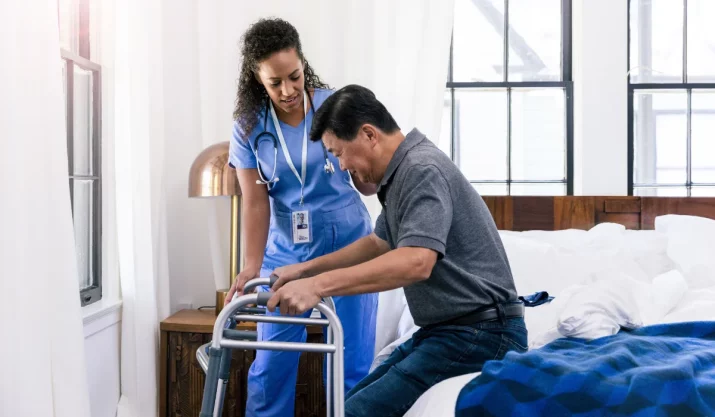How to Use a Cane

Table of Contents
Navigating life’s challenges can be difficult, especially when it comes to maintaining mobility, balance, and stability. As we age or face health issues, finding the right tools to help us keep our independence and improve our quality of life is crucial.
In this blog post, we’ll guide you through selecting and using a walking cane, which can significantly enhance your mobility and confidence. We’ll cover when to consider a cane, how to choose the right one, proper techniques for walking and using stairs, and tips for maintenance and care.
Key Takeaways
- Know when to consider a walking aid, such as a cane, by assessing stability, balance, and mobility needs.
- Select the appropriate cane by evaluating the user’s height, weight, and grip strength.
- Master walking with a cane by practicing proper posture, stance, and various techniques and safety tips to maintain balance.
- Safely navigate stairs with a cane by employing techniques to position the body and cane for maximum stability.
- Extend the lifespan of your cane by practicing proper storage, cleaning, and knowing when it’s time for a replacement.
When Do You Need a Cane?
There are various circumstances under which one might need to use a cane, and it’s crucial to recognize when it’s time to get one. Here are some situations where a cane might be required:
- Balance issues: If you struggle to maintain balance while walking, a cane can offer additional support to help prevent falls and improve your stability.
- Injuries or surgeries: Recovering from an injury or surgery on your leg, hip, or foot may require temporary support from a cane, as it can help take some of the weight off the affected area and facilitate the healing process.
- Chronic conditions: Those with chronic conditions such as arthritis, Parkinson’s disease, or multiple sclerosis may benefit from using a cane to alleviate pain and enhance mobility.
- Muscle weakness: If you’re experiencing muscle weakness in your legs, a cane can support you to move more confidently and independently.
- Fatigue: If you tire easily while walking, a cane can help alleviate some of the strain on your body, allowing you to walk further with less fatigue.
- Age-related decline: Our strength and balance may naturally decrease as we age. In such cases, a cane can offer the support needed to maintain mobility and independence.
Choosing the Right Cane
Selecting the right cane ensures comfort, stability, and effectiveness. A few types of canes are available, each with its unique benefits and features:
- Single-point canes: These traditional canes have a single tip and provide essential support and balance assistance.
- Quad canes: Equipped with four tiny feet at the base, quad canes offer increased stability and weight-bearing capacity.
- Adjustable canes: These can be adjusted to the user’s height requirements, providing a more customized fit.
When choosing a cane, consider the following factors:
- Height: The cane should be appropriate for proper posture and weight distribution. Ideally, your elbow should be at a comfortable 15-20-degree angle when holding the cane.
- Weight capacity: Canes come with different weight capacities. Choose a cane that can support your body weight without bending or breaking.
- Grip strength and comfort: The cane handle should be comfortable to hold and accommodate your grip strength. Various handle styles, such as T-handle, ergonomic, or offset, cater to individual preferences and needs.
Finally, to properly adjust the cane to your height for maximum comfort and stability, follow these step-by-step instructions:
- Stand upright with your shoes on and arms resting naturally at your sides.
- Have someone measure the length from the floor to the crease of your wrist.
- Adjust the cane to match this measurement by loosening the adjustment mechanism, typically a push button or twist lock.
- Once the cane is set to the right height, securely tighten the adjustment mechanism to prevent slipping or movement during use.
- Test the cane by holding it in the hand opposite your weaker or injured leg. Ensure that your elbow is bent at a comfortable 15-20-degree angle and that the cane provides stable support.
Learning to Walk with a Cane
Adapting to walking with a cane may take some time. Still, you’ll quickly become more confident and stable with the correct posture, stance, and techniques. Maintaining proper posture and stance is crucial when using a cane, as it can help you maintain balance and prevent falls.
When walking with a cane, stand straight with your shoulders back and your head facing forward. Hold the cane in the opposite hand to your weaker or injured leg to distribute your weight more evenly and provide better support. Position the cane close to your body for optimal stability.
To walk with a cane
- Start by placing the cane slightly ahead of you, aligned with the toes of your weaker or injured leg.
- Move the cane simultaneously as you step forward with your bad leg. This will provide support and balance as you shift your weight onto that leg.
- Step forward with your stronger leg, moving past the cane and your weak leg.
- Repeat this process, ensuring that the cane and your weaker leg move together in a coordinated manner while your good leg does the heavy work.
While walking with a cane, taking small, controlled steps to ensure better stability and balance is essential. Walking slowly, especially when navigating uneven terrain or unfamiliar environments, can also help minimize the risk of falls. Keeping the cane close to your body can maximize support and reduce the risk of tripping.
Using a Cane on Stairs
Walking up or down stairs with a cane can be challenging. But with proper techniques and precautions, it’s possible to minimize balance problems safely and confidently.
To navigate stairs with a cane
- Stand close to the bottom step, holding the handrail with one hand and the cane with the other.
- Place your cane on the first step while maintaining your grip on the handrail.
- Shift your weight onto your stronger leg; then, step up with your weaker leg.
- Bring your stronger leg up to the same step, keeping the cane in place for added stability.
- Repeat this process for each step, always leading with your weaker leg and cane.
When walking uphill with a cane, place the cane further up the incline to provide additional support as you step forward. Conversely, when walking downhill, position the cane closer to your body and slightly downhill from your current position to maintain stability.
If you find using a cane on stairs too difficult or unsafe, consider seeking assistance from a caregiver or installing a stairlift, home elevator, or other assistive devices to help you move between floors more easily and securely. You should be mindful of your limitations and take precautions to avoid falls or injuries.
Caring for Your Cane
Taking proper care of your cane ensures its longevity and effectiveness. Keeping your cane clean, dry, and stored correctly is crucial to prevent damage and maintain its functionality and appearance.
When not in use, store your cane upright in a cane holder or lean it against a wall where it won’t be accidentally knocked over. Proper storage can prevent unnecessary wear and tear and prolong the lifespan of your cane.
Additionally, cleaning your cane regularly with a damp cloth and mild soap can help prevent the accumulation of dirt and grime. Avoid using chemicals that may damage the cane’s material or finish.
Lastly, inspect your cane regularly for signs of damage, such as cracks in its shaft or handle, worn-down rubber tips, or any bending or warping affecting its ability to support your weight properly. These signs may indicate that it’s time to replace your cane.
If you find that your cane needs replacement, there are certain steps you can take to ensure a smooth transition. Assess the damage to your current cane and determine whether replacing individual parts or the entire cane would be more cost-effective.
If you decide to replace the entire cane, consider the type of cane and features that best suit your needs, such as adjustable height or a comfortable handle.






